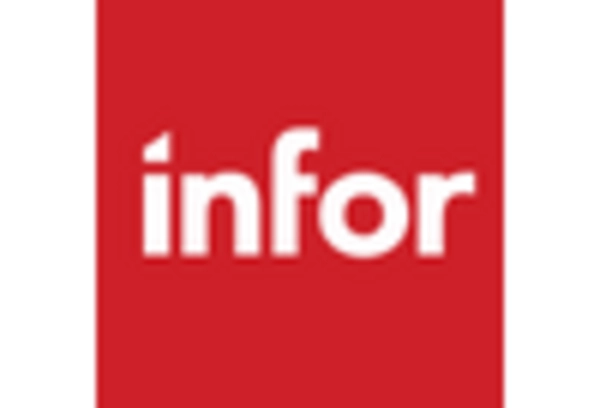Growing E-commerce Sector
The rapid expansion of the e-commerce sector is significantly influencing the Supply Chain Visibility Software Market. As online shopping continues to gain traction, businesses are compelled to enhance their supply chain visibility to meet customer expectations for fast and reliable delivery. The e-commerce market has seen exponential growth, with projections indicating that it could reach trillions in revenue in the coming years. This growth necessitates sophisticated visibility solutions that can track orders, manage inventory, and optimize logistics. Companies that invest in supply chain visibility software are better positioned to handle the complexities of e-commerce logistics, ensuring timely deliveries and improved customer satisfaction. Thus, the burgeoning e-commerce landscape is likely to serve as a catalyst for the Supply Chain Visibility Software Market, driving innovation and investment in visibility solutions.
Rising Demand for Real-Time Data
The increasing need for real-time data in supply chain operations is a primary driver for the Supply Chain Visibility Software Market. Companies are recognizing that timely access to information can enhance decision-making processes and improve operational efficiency. According to recent estimates, organizations that implement real-time visibility solutions can reduce their supply chain costs by up to 20 percent. This demand is fueled by the necessity to respond swiftly to market changes and customer needs, thereby fostering a competitive edge. As businesses strive for agility, the adoption of software that provides real-time insights into inventory levels, shipment statuses, and supplier performance is likely to grow. Consequently, this trend is expected to propel the Supply Chain Visibility Software Market forward, as firms seek to leverage technology to optimize their supply chain operations.
Increased Focus on Risk Management
The heightened awareness of risks associated with supply chain disruptions is driving the Supply Chain Visibility Software Market. Companies are increasingly investing in visibility solutions to identify potential risks and mitigate them proactively. The ability to monitor supply chain activities in real-time allows organizations to respond to disruptions, such as supplier failures or transportation delays, more effectively. Research indicates that businesses with robust visibility tools can reduce the impact of disruptions by approximately 30 percent. This focus on risk management is particularly pertinent in industries where supply chain resilience is critical. As organizations prioritize risk assessment and management, the demand for supply chain visibility software is expected to rise, further influencing the dynamics of the Supply Chain Visibility Software Market.
Regulatory Compliance and Standards
The increasing complexity of regulatory requirements is a significant driver for the Supply Chain Visibility Software Market. Companies are under pressure to comply with various regulations related to product safety, environmental standards, and trade compliance. Visibility software enables organizations to track and document their supply chain processes, ensuring adherence to these regulations. The demand for compliance-related visibility solutions is expected to grow as businesses seek to avoid penalties and enhance their reputations. Furthermore, the ability to demonstrate compliance through transparent supply chain practices can provide a competitive advantage. As regulatory landscapes evolve, the Supply Chain Visibility Software Market is likely to experience heightened demand for solutions that facilitate compliance and enhance operational transparency.
Technological Advancements in Data Analytics
Technological advancements in data analytics are reshaping the Supply Chain Visibility Software Market. The integration of advanced analytics tools allows companies to derive actionable insights from vast amounts of supply chain data. These insights can lead to improved forecasting, inventory management, and overall supply chain efficiency. The market for analytics-driven visibility solutions is projected to grow as organizations recognize the value of data in optimizing their supply chains. Enhanced analytics capabilities enable businesses to identify trends, predict disruptions, and make informed decisions. As technology continues to evolve, the Supply Chain Visibility Software Market is likely to benefit from innovations that enhance data analytics, driving further adoption of visibility solutions.


















Leave a Comment